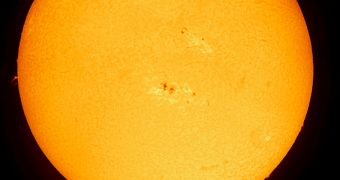On Tuesday, February 4, 2014, an active region on the surface of the Sun called AR 1967 exceeded the size of planet Jupiter, becoming one of the largest AR on record. This record was broken one day after AR 1967 released no less than 7 M-class (medium) solar flares in short succession.
The solar structure is in fact made up of a giant group of sunspots, says sky photographer John Chumack, who sent the image above to Space. Previously known as AR 1944, this active region is responsible for producing the first X-class (very strong) solar flare of 2014, at the beginning of January.
The outer surface of the Sun is heated to around 5,500 degrees Celsius (10,000ºF). By comparison, sunspots are slightly cooler, averaging 3,500ºC, or 6,400ºF. This difference is the reason why these structures appear darker in solar observatory images of the yellow dwarf star.
The Sun was supposed to reach the peak of its 11-year cycle, called the solar maximum, in late 2013, but intense solar activities were delayed for some reason. In early 2014, the star showed signs that it was seeking to make up for the lost time. A solar cycle features alternative periods of maximum and minimum sunspot activity.

 14 DAY TRIAL //
14 DAY TRIAL //